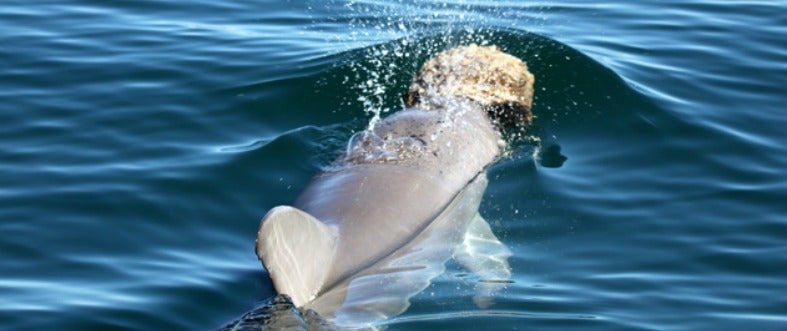Title: Humans, Dolphins Only Mammals to Socialize Based on Subcultures
Georgetown researchers have discovered that bottlenose dolphins are the only mammals besides humans to associate with one another based on cultural behavior with tools.

Just as humans might bond over a mutual interest in gardening, these creatures of the sea tend to associate with one another based on their use of marine sponges as hunting tools.
“Among species that learn to use tools, all members of the population engage in the same behavior,” says biology professor Janet Mann, the study’s first author, who has studied the dolphins in Australia’s Shark Bay for more than 25 years. “Most dolphins in the bay do not use tools – but some dolphin calves learn to use sponge tools from their mothers, and this influences their social preferences later on.”
So-called “spongers” obtain and wear basket sponges on their beaks while lightly scouring the sea floor for prey in deep channels. But non-spongers are more prevalent among bottlenose dolphins.
Dolphin Cliques
The study was published today in the online journal Nature Communications.
It also showed that female dolphins who use marine sponge as hunting tools are more cliquish with each other than non-spongers.
“Hunting with sponges is a solitary behavior, so it is all the more remarkable that dolphins prefer to spend time with others that use sponges even though they don’t use them together,” Mann says. “This suggests that spongers not only identify who is a sponger and who is not, but also have some type of group identity.”
Co-authors of the study include Margaret Stanton, who received her Ph.D. in biology in 2011, Eric M. Patterson, a biology department Ph.D. candidate, Elisa Bienenstock, a School of Nursing & Health Studies associate professor of human science, and Lisa Singh, associate professor in the computer science department.
A number of national news organizations wrote about the research, including thisUSA TODAYarticle.
Unique to Dolphins
In virtually all other cases of animal tool-use or cultural behavior, the authors say, all members of the group participate. But this is not the case with the dolphins they studied.
The researchers examined the social networks of sponger and non-sponger bottlenose dolphins in Shark Bay, Australia, for more than 20 years, and found this preference for spongers to associate with other spongers in every single analysis.
Maternal kinship, gender and location also contributed to preference, but when these factors were controlled for, spongers still showed a strong preference for others like themselves.
Dolphins, like humans, vary in the frequency of their social interactions from day to day. A dolphin may spend 24 hours alone, for example, or spend that time associating with 50 different dolphins.
Spongers choose to spend time with other spongers over non-spongers. In contrast, baboon troop members typically spend all their time in one group.
A Grouping Function
In other animal populations, individuals develop a behavior because they are part of a group, as opposed to grouping because of a behavior, the researchers say.
Since sponging is a solitary behavior (except when calves accompany their mothers during sponging and learn the behavior from them) affiliation among spongers is not based on collective foraging, but on identifying other individuals as spongers.
“These patterns are remarkable,” the authors write, “because spongers lead a relatively solitary lifestyle and have weaker ties with other dolphins than non-spongers do.”
First Non-human Subculture
Given that the authors only included non-spongers in the same habitat as the spongers, they find the results even more striking.
The researchers say the study is the first demonstration that a behavior transmitted by single mother dolphins to their calves serves a grouping function as well.
“To date, no material subcultures have been identified outside of humans,” the authors write.
“Recently, many biologists are moving beyond genetic inheritance to examine the processes involved in inclusive heritability, which includes culture,” Mann notes. “We sometimes think that traits such as culture are exclusively human, but a growing body of literature proves otherwise.”